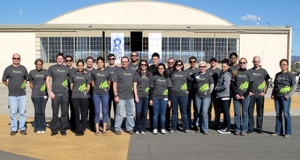Sep 25 2013
A collaborative team of Arizona State University and University of New Mexico (UNM) students is set to participate in the 2013 U.S. Department of Energy’s Solar Decathlon. The international competition challenges student teams from institutions of higher education to design, construct and operate solar-powered houses that are functional, energy-efficient and attractive.
 A collaborative team of ASU and University of New Mexico students is set to participate in the 2013 U.S. Department of Energy’s Solar Decathlon. The team is one of only 20 from across the globe selected to compete in the biennial event.
A collaborative team of ASU and University of New Mexico students is set to participate in the 2013 U.S. Department of Energy’s Solar Decathlon. The team is one of only 20 from across the globe selected to compete in the biennial event.
The team, called ASUNM, is one of only 20 from across the globe selected to compete in the biennial event, which takes place Oct. 3-13, at the Orange County Great Park in Irvine, Calif.
The team’s project, named SHADE – Solar Homes Adapting for Desert Equilibrium – is an adaptable 800-square-feet living space powered by solar panels and designed for an older, active couple.
Designed for a Southwest desert environment, the house features multiple patios to merge indoor and outdoor areas and create a fluid, expansive living space that can meet the changing needs of its occupants.
Alia Taqi, an ASU student pursuing her master’s degree in architecture, is the media manager for the team. She says working on SHADE has been almost a two-year-long exercise.
“It has been a great learning process,” Taqi says. “Building a house from the ground up to meet specific requirements is no easy feat, but we’ve done it as a team. After an initial mock display, the house is now disassembled and on its way to California where we will reassemble the home and demonstrate its uniqueness and energy efficiency.”
Architecture
ASU architecture graduate student John Cribbs, the architecture manager for the SHADE project, says the structure is a living laboratory focused on sustainable building principles, resource usage, and energy generation and management. He says the symbiotic relationship between the Mesquite tree and a young saguaro cactus inspired SHADE’s design.
“Placing the solar canopy at a fixed angle on top of the exterior patio instead of the roof allowed us to create and shade the space below it,” says Cribbs. “Another innovative feature of the house is the use of a rain-screen cladding system – a form of double-layered construction that uses an outer layer to function as the skin that vents hot air, and an inner layer that reduces energy losses. To further lower energy costs, we used a type of framing system that creates more space for insulation.”
Interior design
To develop SHADE as a flexible living space, the ASUNM team focused efforts on building the house as a mosaic of modules that can be plugged onto the main structure as needed. The modules also allow the house to be versatile in its functions.
“The home is adaptable, self-sustaining and can serve as a communal gathering space if needed,” says Jessica Purcell, a member of the team’s interior design, architecture and construction units. “The flex-space, which is a large living room, can be turned into a bedroom at night and an office during the day. It can also serve as an extension for living and dining rooms.”
Kevin Christensen, Purcell’s teammate, says the flexibility of the exterior decking allows the home to become one with its surroundings.
“Using living technologies as part of a sustainable infrastructure helps cool the house through passive solar gain and shading,” he says. “An example is a custom green screen that is fitted to the west and south facades of the structure that reduces absorption of heat. These strategies increase flexibility, comfort and the residents’ engagement with their neighbors.”
Landscape design
Ali Abbaszadegan, landscape architect for the team, notes that plant materials for the landscape are native to the Sonoran and Chihuahuan deserts and use minimal water. He says the landscape design for the home can be used as an interpretive garden to help educate the public about the diversity and beauty of desert environments.
The SHADE house also features a hummingbird and butterfly garden that invites fauna that help pollinate and shape a complete ecosystem. The landscape will be watered with the help of a gravity-fed hose using collected rainwater from a storage tank.
The process will allow the homeowner “to engage and understand the biodiversity within their garden while also maintaining it,” Abbaszadegan explains. “We also want to mitigate energy consumption and enhance other systems in the space to be more sustainable and aesthetically pleasing.”
Engineering
Several students in ASU’s Del E. Webb School of Construction Programs provided residential construction expertise for the SHADE project.
The group handled preconstruction logistics and determined what materials would be most effective for the home’s structural foundation and framework. They were also instrumental in determining how – and at what size – the structure could be built so that it can be efficiently disassembled for transport to the Solar Decathlon event in California, and then reassembled.
The team got guidance on the design and installation of the home’s solar-energy system from engineers working with the Quantum Energy and Sustainable Solar Technologies (QESST) engineering research center headquartered at ASU.
QESST is a multi-university collaboration sponsored by the National Science Foundation and Department of Energy that is working to advance photovoltaic technology as a tool for generating energy from sunlight. UNM is one of the QESST center’s partners.
The Solar Decathlon competition is open to visitors each Thursday through Sunday during the 11-day event. For more information, visit solardecathlon.gov.
After the event, the SHADE home will be on display at UNM for several months before being brought back to Arizona. The structure will be put on public exhibit in central Phoenix as part of the city of Phoenix PHX Renews sustainable living project.